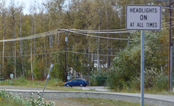Headlights
 Headlights on the Alaska Highway. Photo by Joanna Reed, Alaska DOT&PF. |
 Headlights are ON. Photo by Joanna Reed, Alaska DOT&PF. |
Headlights are a low-cost method to reduce crashes by increasing vehicle conspicuity and making it easier to detect approaching vehicles from farther away. Nearly all published reports indicate the use of headlights reduce multiple-vehicle daytime crashes, including studies conducted in Scandinavia, Canada, and the United States. Available studies document crash reductions of 5% to 15% due to the use of daytime headlight use.
If you don’t have driving running lights, then manually turn on your headlights, if you want to perform one of the easiest tasks to prevent a traffic crash. And the light bell will sound as a reminder to turn them off in some vehicles.
Why use headlights in Alaska?
For the same reason that northern countries as Canada Finland Sweden Norway Iceland Denmark: to prevent head-on collisions. In our hemisphere, during both summer and winter greater judgment is required because:
- the twilight period is quite long
- the shadows produced by low sun angles in the summer often reduce visibility of vehicles
- vehicles take on a grey tint and become camouflaged against the surrounding grey-tinted sky, mountains, buildings and roads.
- deep shadows can make a car nearly invisible even on the brightest days of the year
What is the law in Alaska?
Motorists in Alaska must drive with headlights on where a roadway is posted to do so.
13 AAC 04.010. When lights are required
(a) Every vehicle traveling on a highway or other vehicular way or area within the state must illuminate lights
(1) between one half hour after sunset and one half hour before sunrise; or
(2) at any other time when, because of insufficient light or other atmospheric conditions, persons or vehicles on the highway are not clearly discernible at a distance of 1000 feet.
(b) Stop lights, turn signals, and other signaling devices must be illuminated as required by this chapter.
(c) Every vehicle traveling on a highway or vehicular way or area must illuminate lights when traveling on any roadway that is posted with signs requiring the use of headlights.
(d) For the purposes of (c) of this section, lights include low intensity headlights and daytime running lamp devices that meet the standards in 49 C.F.R. 571 (revised as of August 29, 1996), if the headlights are not otherwise required under (a)(1) or (2) of this section.
What is Alaska doing to prevent head-on collisions?
During the summer of 2011, the Department of Transportation and Public Facilities, in consultation with the Department of Public Safety, installed headlight signs along the four designated safety corridors based upon the 2010 Safety Corridor Audit. The Sterling, the Seward, the Parks and the Knik-Goose Bay Roads all have signs along their designated corridors. The purpose is to maximize lives saved at the least public cost on the existing roadway, until such time as significant permanent and lasting road improvements can be made. Centerline rumble strips were installed in Safety Corridors in 2010 in order to reduce head-on collisions by one-quarter or greater, as is often the result in other states.
It is the responsibility of the State of Alaska and all drivers to take as many actions as possible to prevent deaths and major injuries on our highways. In the case of Safety Corridors, the State of Alaska is taking our highest volume, highest risk roadways and increasing the requirement for us all in order to reduce risk and save lives for all residents and visitors.
The State of Alaska is actively engaged in the headlights issue; describing the requirement in media and anywhere signs are posted the Alaska State Troopers are stopping and educating motorists, and if appropriate, writing a $60.00 2-point citation.
Will DRLs shorten headlamp bulb life or lower fuel economy?
Running vehicle lights in the daytime does not significantly shorten bulb life. Systems like those on General Motors cars that use high beams are designed to operate at half their normal power during daylight hours, thereby conserving energy and reducing the effect on a vehicle's fuel economy. The National Highway Traffic Safety Administration (NHTSA) estimates that only a fraction of a mile per gallon will be lost, depending on the type of system used. GM estimates the cost to be about $3 per year for the average driver.
Are motorcycles required to have DRLs?
Federal law does not require motorcycles to have DRLs, but some states, like Alaska, require motorcyclists to ride with their headlights on at all hours. Since 1979 most manufacturers have equipped their cycles with automatic-on headlamps.
Publications
Safety Topics
- DEC / DRE
- Distracted Driving
- Fatality Analysis Reporting System (FARS)
- Headlights
- Media Campaigns
- Occupant Protection
- DUI Information & Impaired Driving
- Senior Driving in Alaska
- Teen Driving in Alaska
- Traffic Records

